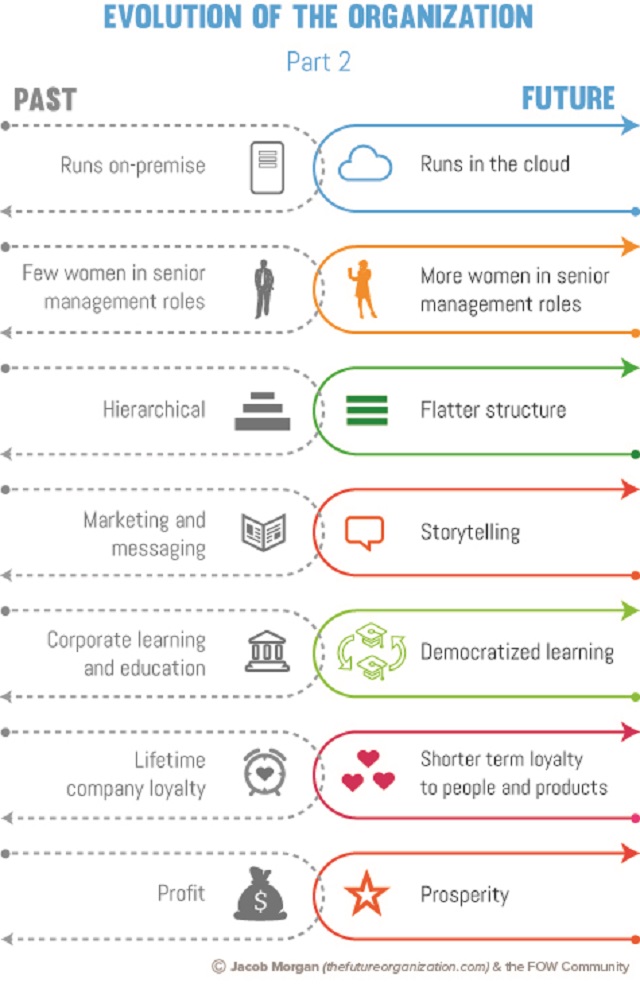This concept and visual was taken from my new book, The Future of Work: Attract New Talent, Build Better Leaders, and Create a Competitive Organization.
A few days ago I introduced part 1 of The Evolution of Organizations so if you haven’t read/seen that post yet then I highly recommend you check it out prior to reading this one. Today I wanted to introduce the second part of that graphic (and later I will release a full combines version) which continues to explore that evolution which you can see below.

Cloud vs on-premise
One of the keys that will enable organizations to evolve from a technology perspective is their shift from on-premise to cloud. In fact it’s hard to imagine this shift not becoming the standard over the next few years. Shifting to the cloud allows for benefits such as faster upgrade time, improved flexibility, reduced costs, and increased accessibility and adoption of the technology platforms.
Women in management
Today there are approximately 15% of women in executive officer positions in the U.S. which is a shockingly low number. One of the things we can expect to see is an increase in this number. Have more women in management sees dramatic positive impacts on organizations such as higher return on equity, sales, and on invested capital.
Change in organizational structure
I’ve spoken with, worked with, and have researched hundreds of organizations over the past few years. I’ve never met an executive or manager who said “we need more hierarchy” or “we need more layers.” In fact the exact opposite is true, organizations are trying to “flatten” their structure to improve communication and collaboration. This means that the traditional strict pyramid hierarchy no longer makes sense for the modern organization and we will be evolving to flatter more nimble structures.
Story-telling
We used to assume that this was only important for attracting customers. However, when it comes to creating a desirable employee experience and one where employees can relate to the company they are working at and align their values; nothing is more powerful than story-telling. Employees must understand WHY the organization exists and then they can help figure out HOW to make the organization successful.
Democratized learning
In most organizations around the world today if you want to learn how to do something you usually have to take a class that the company may or may not offer. Oftentimes you travel to another location, listen to a guest speaker, watch some videos, read through a training manual, and maybe do some hands-on excursuses. In other words, your entire education and learning is dependent on the organization. However we are seeing this evolve so that any employee can educate or learn from any other employee. This is largely possible through technology such as internal collaboration platforms and social networks.
Loyalty 2.0
Life-time and long-term loyalty are completely dead as is the notion of job security and pension plans. The average employee tenure today is under 5 years and for millennials it’s under 3 years. Loyalty is becoming more geared towards projects, managers, or co-workers as opposed to the organization as a whole. Companies must switch from a long-term career mentality to a shorter term project term mentality.
From profits to prosperity
Profit is just the financial gain that an organization generates and has always been the primary measure of success. When it comes to the future of work money will no longer be the primary success factor that organizations are measured by. Instead factors such as health and wellness, community involvement, employee happiness, sustainability, world-impact, and the like, will be the new measures of success.
